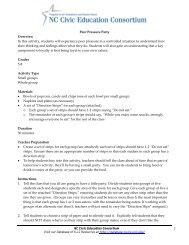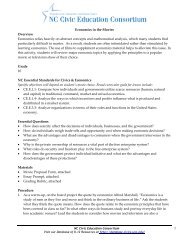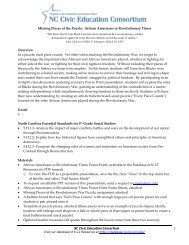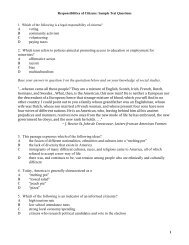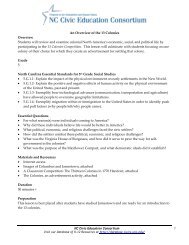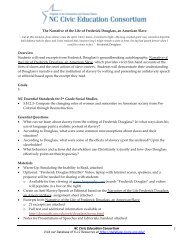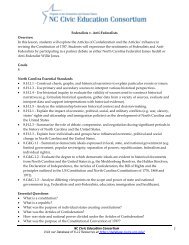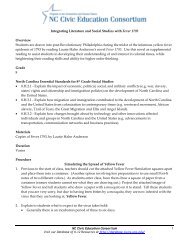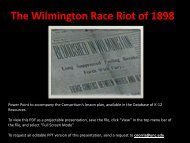TRANSATLANTIC SLAVE TRADE - Database of K-12 Resources
TRANSATLANTIC SLAVE TRADE - Database of K-12 Resources
TRANSATLANTIC SLAVE TRADE - Database of K-12 Resources
You also want an ePaper? Increase the reach of your titles
YUMPU automatically turns print PDFs into web optimized ePapers that Google loves.
Voices from The<br />
Transatlantic<br />
Slave Trade<br />
Power Point accompaniment for the lesson Voices <strong>of</strong> the Trans-Atlantic Slave Trade, available in the <strong>Database</strong> <strong>of</strong><br />
K-<strong>12</strong> <strong>Resources</strong>.<br />
To view this PDF as a projectable presentation, save the file, click “View” in the top menu bar <strong>of</strong> the file, and<br />
select “Full Screen Mode”<br />
To request an editable PPT version <strong>of</strong> this presentation, send a request to cnorris@unc.edu
Trans-Saharan Slave Trade<br />
• Between the 10 th – 14 th centuries, African<br />
captives were sold in Islamic markets around<br />
the area <strong>of</strong> present-day Sudan.<br />
• Many <strong>of</strong> the captives were female, sold for<br />
servants or concubines.
• Other captives were shipped north across the<br />
deserts <strong>of</strong> northwest Africa to the Mediterranean<br />
coast (to Morocco).<br />
• Africans were purchased there to work as servants<br />
in Spain, Portugal, and other countries.<br />
• By the mid-1400’s, Portuguese ship captains were<br />
trading slaves along the west coast <strong>of</strong> Africa for<br />
working on sugar plantations.
Trans-Atlantic Slave Trade<br />
• In 1492, Columbus landed in the “New World.” This new link<br />
between continents opened the door for the beginning <strong>of</strong> the<br />
Trans-Atlantic slave trade.<br />
• Spanish adventurers and conquistadors arrived in the<br />
Americas throughout the following years, enslaving Native<br />
Americans to search for gold and silver.<br />
• Natives were weakened by disease, malnutrition, and Spanish<br />
cruelty.<br />
• As the Native American population decreased, the Spanish<br />
government turned to African slaves to replace the enslaved<br />
Native work force.<br />
• Around 1520, the first African slaves arrived in the Americas<br />
<strong>of</strong>f <strong>of</strong> Portuguese ships.
Trans-Atlantic Slave Trade<br />
• In 1492, Columbus landed in the “New World”,<br />
beginning the Trans-Atlantic slave trade.<br />
• Spanish adventurers arrived in the<br />
following years, enslaving Natives to<br />
search for gold and silver.<br />
• Natives were weakened by disease,<br />
malnutrition, and Spanish cruelty.<br />
• Around 1520, the first African slaves arrived<br />
in the Americas <strong>of</strong>f <strong>of</strong> Portuguese ships.
Triangle Trade<br />
Route
The Middle Passage
What do you think life aboard a slave ship<br />
would have been like
• People were packed into ships on numerous wooden<br />
platforms between decks.<br />
• These decks were generally around 4x6, with little head<br />
room.<br />
• The captured suffered from scrapes, bruises, and<br />
infections from lying on these bare, unsanitary planks.
•Once enslaved, the men and women were<br />
typically confined by leg irons while on the ship.<br />
•They were <strong>of</strong>ten tortured with whip beating and<br />
iron collars.
• Conditions below deck were crowded and unsanitary.<br />
The wooden holding areas were covered with excrement,<br />
blood, and filth. Only tubs were provided for people to<br />
relieve themselves.<br />
• Due to these poor conditions, many <strong>of</strong> those captured<br />
suffered and died from diseases such as dysentery,<br />
dehydration, smallpox, and gastrointestinal diseases.<br />
• Many committed suicide by jumping overboard or<br />
refusing to eat. Iron poles were sometimes used to force<br />
feed those enslaved.
15%-20% <strong>of</strong> enslaved people usually died on the journey<br />
to the Americas, a trip generally taking several miserable<br />
months.
Imagine:<br />
What is he thinking<br />
…hoping<br />
…wishing<br />
…remembering<br />
…seeing<br />
…feeling
Assignment: African Journals<br />
Africans who were sold into the slave<br />
trade had identities beyond being “a slave”.<br />
They were people living their lives, surviving<br />
as human beings, and performing day to<br />
day activities. These people were<br />
individuals with skills, hopes, dreams, and<br />
feelings.<br />
They had identities beyond the world<br />
they were forced into once captured.<br />
Students will assume the role <strong>of</strong> an<br />
African and create their personal<br />
journal that details their life both before<br />
and after being sold into slavery.
Step for Completion:<br />
1. Brainstorm<br />
2. Choose a region <strong>of</strong> Africa and a particular time period<br />
to research. In your research, focus on finding out<br />
information that will help you infer your characters day to<br />
day life. For example, you may want to find out<br />
information about:<br />
-Environment<br />
-Jobs and daily habits<br />
-Culture and traditions<br />
-Religion<br />
-Habitat
Step for Completion:<br />
3. Choose an African name and begin to imagine this<br />
person’s life.<br />
Women<br />
• Adanna<br />
• Adetokumbo (ah-Deh-toh-koom-boh)<br />
• Adebumi (Ah-day-boo-me)<br />
• Adowa (ah-doo-wah)<br />
• Aina (eye-nah)<br />
• Dacia (day-sha)<br />
• Dericia (Dah-ree-sha)<br />
• Tanginika (Tann-J-Nee-ka)<br />
• Takiyah<br />
• Tatu<br />
• Obax (OH-bah)<br />
• Obioma (O-be-o-ma)<br />
NAME EXAMPLES<br />
• Babu<br />
• Babtund<br />
• Banga<br />
• Faraji<br />
• Fela<br />
• Abimbola<br />
• Adisa<br />
• Ad<strong>of</strong>o<br />
• Kantigi<br />
• Kashka<br />
• Zahur<br />
• Zere<br />
Men
4. As you brainstorm and imagine, begin to create your<br />
African’s journal entries. Your beginning entries should be<br />
set in your African home.<br />
In your beginning entries, consider:<br />
-Who are you<br />
-Describe where you live.<br />
-What do you do each day<br />
-Who is around you Who do you spend your time<br />
with<br />
-What do you enjoy<br />
-What are your hopes and dreams<br />
-What are your skills<br />
-What do you dislike
5. Middle entries (After your capture, the voyage across<br />
the Middle Passage, and your arrival in the Americas)…<br />
-Where are you while writing each entry (on a boat, in a<br />
cell/stockade, at a sale…)<br />
-How were you captured Who captured you What<br />
were you doing before captured What was your life<br />
like before captured<br />
-What is happening around you<br />
-What do you see Smell Hear Feel Hope Fear<br />
Wish<br />
-How are you handling this situation<br />
-How are others around you handling this situation<br />
-What do you think is going to happen<br />
-How are you managing to survive
6. Final entries…<br />
-What have you discovered about yourself<br />
-What are your reflections regarding this experience<br />
thus far<br />
-What happens to you (Does your journal have an<br />
ending entry, does the writing simply drop <strong>of</strong> the page<br />
and we never know, etc.)<br />
Assignment Due Date: ____________________________



